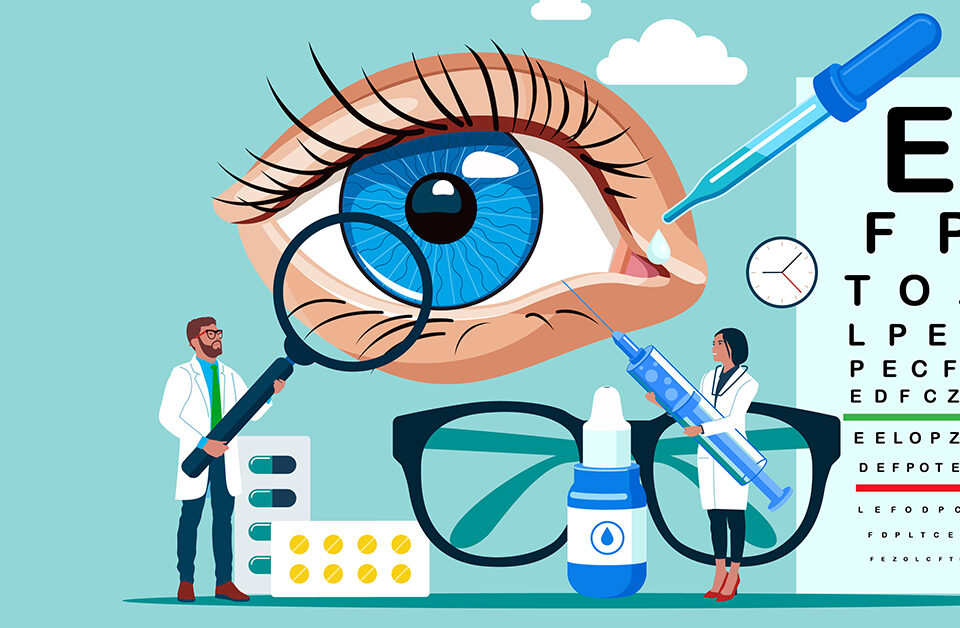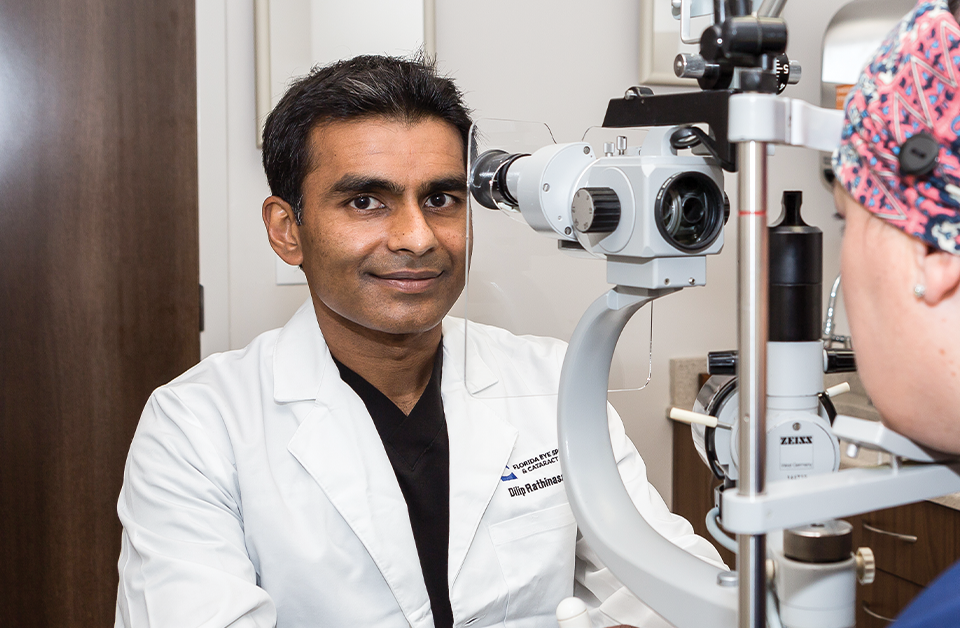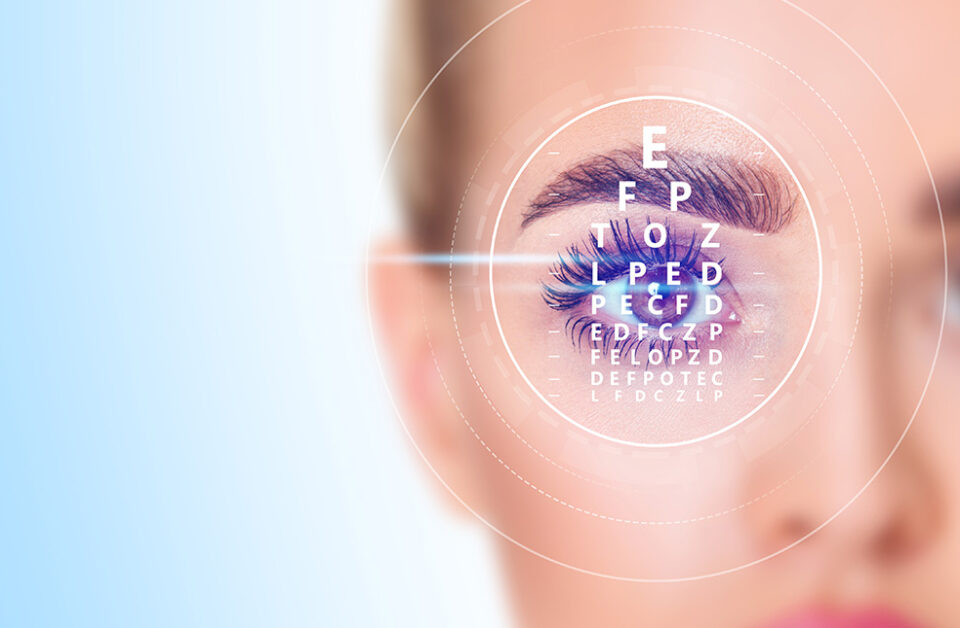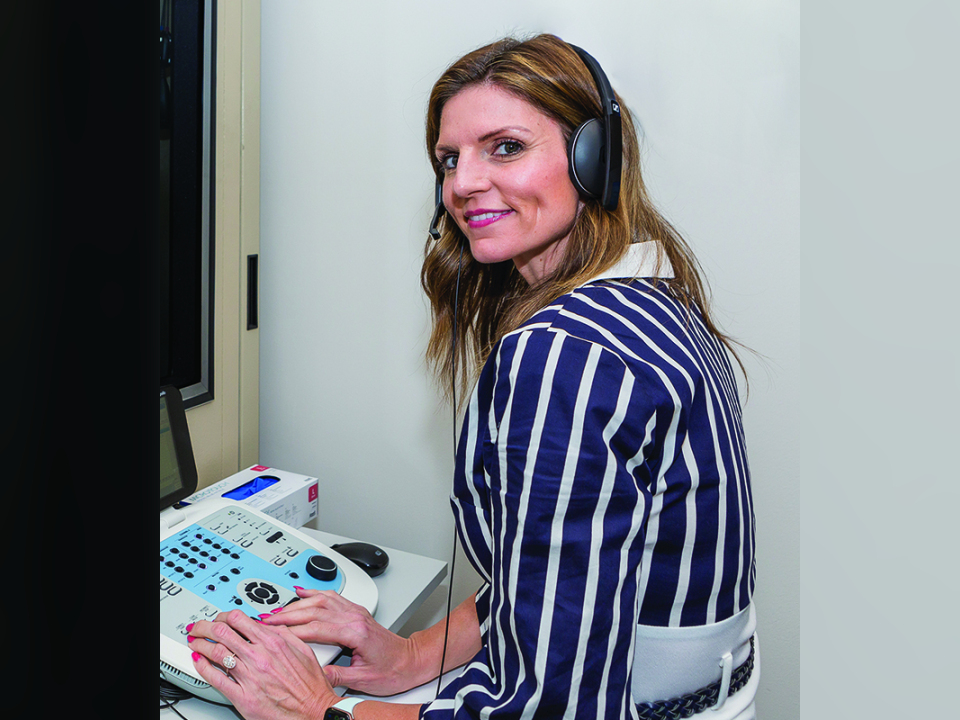

Jordan Pysz / ifoundmydoctor.com
Dr. Patel examines a patient’s retina, which he considers to be the most important part of the eye.
He admits he might be biased, but to Nandesh N. Patel, MD, the retina is the most important part of the eye.
The retina, Dr. Patel explains, is a thin layer of specialized tissue that lines the back of the eye. It senses light as it enters the eye, converts the light into electrical signals and sends those signals via the optic nerve to the brain, where they are processed as images.
A board-certified ophthalmologist and fellowship-trained retina surgeon at Florida Eye Specialists & Cataract Institute. Dr. Patel says the retina is unlike any other part of the body and therefore merits extraordinary care.
“Think of the eyeball as a camera,” he describes. “There are two crucial elements: the lens to focus the light and the film to register the light that enters. The retina is the film. Any disease that compromises the quality of the film creates problems with the pictures processed by the eye, resulting in a reduction of vision.
“The retina is a critical structure and, as I tell my patients, with each body part there’s a disorder to go with it. Unfortunately, there are many disorders that affect the retina.”
The most common disorders are diabetic retinopathy and macular degeneration, the leading causes of blindness in adults. Dr. Patel and his institute colleagues, board-certified ophthalmologists and fellowship-trained retina specialists Evan N. Dunn, MD, Marguerite Kohlhepp, MD, and Dan P. Montzka, MD, have expertise in treating these diseases and more.
Diabetic Retinopathy
According to the Centers for Disease Control and Prevention, about 34.2 million people in the United States — just over one in 10 — have diabetes. Type 2 diabetes, which accounts for 90 to 95 percent of all diabetes cases, is the leading cause of blindness among people ages 20 to 74 due to diabetic retinopathy.
Diabetic retinopathy is the most common eye disease associated with diabetes. It is caused by changes in the blood vessels of the retina. In some cases, abnormal blood vessels develop on the surface of the retina. In others cases, blood vessels begin to bleed or leak fluid.
“Anyone who has diabetes is at risk for developing diabetic retinopathy,” Dr. Dunn stresses. “And the risk increases with the duration of having the disease.
“The main reason: High glucose levels affect the blood vessels and make them unhealthy. Diabetic retinopathy generally has no symptoms in its early stages, so screening and early diagnosis are of incredible importance. We have treatments that will overturn poor visual outcomes, but they require early detection.”
There are two main types of diabetic retinopathy, nonproliferative and proliferative.
“The nonproliferative type is an early stage of diabetic retinopathy characterized by small outpouchings of normal blood vessels called microaneurysms and tiny areas of bleeding within the retina,” Dr. Dunn explains.
“These retinal changes may progress to a much more serious type of diabetic retinopathy that, if left untreated, may cause permanent vision loss. We monitor patients with this condition routinely to make sure that if worsening occurs we can treat it before the patients lose vision.”
Nonproliferative is the more manageable form of diabetic retinopathy, he adds.
“If a patient works to control the underlying diabetes with a primary care physician, then it’s possible to reverse some of the findings,” Dr. Dunn states.
With proliferative diabetic retinopathy, the patient experiences an advanced form of the disease marked by an extensive closure of retinal blood vessels. As a result, the retina begins to grow leaky blood vessels in an effort to resupply blood to the area where the original vessels closed. Partial or total vision loss may occur.
“Unfortunately, these new vessels are abnormal and are not able to supply the retina with normal blood flow,” Dr. Dunn informs. “Instead, fluid leaks into the vitreous, the gel that lies in front of the retina and behind the lens, causing a vitreous hemorrhage. Small scars also begin to develop on the retina and the vitreous, causing the retina to pull away from the back of the eyeball, resulting in a retinal tear or retinal detachment.
“Once you get into the proliferative states, aggressive treatment is necessary. Some patients will undergo regular treatments such as laser therapy, monthly injections of medication directly into the eye or, in extreme cases, surgery.”
The CDC reports that early detection and treatment of diabetic retinopathy can reduce the development of severe vision loss by an estimated 50 to 60 percent.
“Early detection and treatment are crucial to preventing vision loss,” Dr. Dunn confirms. “Generally, diabetic retinopathy does not exhibit any symptoms during its early stages. Sometimes, a change in eyesight does not occur until the disease has progressed. Proper monitoring of the eyes is the best prevention for diabetic retinopathy.”
Macular Degeneration
Another serious threat to sight as people age is macular degeneration. It occurs when the central area of the retina, called the macula, deteriorates and main images become less discernible.
“Think of the retina as being 10 layers thick with many blood vessels nourishing it,” Dr. Montzka describes. “Macular degeneration is a disease in which some of those layers essentially become diseased and waste away. As a consequence, some of the blood vessels pop and leak.
“The first situation, where the layers waste away, is what we consider dry macular degeneration. When blood vessels start popping and leaking, that’s wet macular degeneration. This type does considerable damage that translates into poor vision.”
Dry macular degeneration accounts for approximately 90 percent of all cases of macular degeneration, which is more common in people 55 and older. Because it occurs so often as people age, it is often referred to as age-related macular degeneration, or AMD.
Macular degeneration generally has no signs or symptoms in its early stages.
“Macular degeneration progresses like a slow-moving conveyor belt,” Dr. Montzka notes. “Every case of wet macular degeneration was at one time dry macular degeneration. Some patients may have had the dry form for a long time without being aware of it. Those patients are often shocked by the diagnosis because they had no corresponding symptoms.”
When there are symptoms, people might notice a gradual loss of their ability to see objects clearly, especially noticing a blurring of areas of type on a page of print, or dark or empty spaces that may block the center of their field of vision.
Some patients may notice that straight lines in the landscape — such as telephone poles, the sides of buildings or streetlight posts — appear wavy, crooked or distorted. Some may notice the need for brighter light when reading or a gradual loss of color intensity.
“For intermediate-level dry macular degeneration, specific vitamin supplements can help slow down the conveyor belt,” Dr. Montzka reports. “They don’t halt progression of the disease and they certainly don’t reverse it. But they can buy the patients time. For example, if they would normally develop wet macular degeneration in five years, this treatment may give them 10 to 15 years, which is substantial.
“With the wet form, which is an end stage of the disease, we have a variety of medications that are injected directly into the patient’s eye on a monthly basis. These can help contain the amount of leakage and bleeding and can often result in a stabilization of the eye, but not improvement.”
Recent Advancements
The various medications used in the treatment of wet macular degeneration inhibit the release of vascular endothelial growth factor (VEGF), which promotes the formation of the abnormal blood vessels associated with the disorder.
Those FDA-approved anti-VEGF medications include bevacizumab (brand name AVASTIN®), ranibizumab (LUCENTIS®), aflibercept (EYLEA®) and faricimab-svoa (VABYSMO™).
“VABYSMO was approved by the FDA in 2022,” Dr. Kohlhepp informs. “It is used to treat wet macular degeneration as well as diabetic macular edema, which is swelling in the center portion of the retina. Diabetic macular edema is a complication of diabetic retinopathy.”
VABYSMO has two components. It has the VEGF inhibitor and an ANG-2 inhibitor. ANG-2 is angiopoietin-2, which instigates blood vessel growth as well as inflammation. These are key factors in the development of retinal eye diseases, including macular degeneration and diabetic macular edema. Inhibiting ANG-2 helps alleviate swelling in the macula.
“The advantage of VABYSMO over the older drugs is that it is reported to have better durability, to last longer in the eye,” Dr. Kohlhepp states. “That means patients can receive fewer injections and have longer intervals between appointments.”
While there have been treatment options for wet macular degeneration for years, there has never been a treatment for dry macular degeneration in the United States. Until now.
“In February, the FDA approved SYFOVRE™, the first injectable medication to treat dry macular degeneration,” Dr. Kohlhepp enthuses. “SYFOVRE (pegcetacoplan injection) is a complement inhibitor. It works on a different mechanism than the VEGF inhibitors.
“SYFOVRE is used to treat a severe form of dry macular degeneration called geographic atrophy and stop it from progressing. Geographic atrophy is a chronic, progressive degeneration of the macula. It is the last stage of dry macular degeneration.”
Dr. Kohlhepp encourages patients with dry macular degeneration to visit Florida Eye Specialists & Cataract Surgery to determine if they are candidates for treatment using SYFOVRE.
Dr. Kohlepp also encourages patients with macular degeneration to monitor their vision daily with an Amsler grid, a special tool that consists of horizontal and vertical lines with a dot in the center.
People look at the grid intently. If the lines begin to look wavy or distorted, or if areas of the grid are blocked by small blind spots, macular degeneration may be progressing. In those cases, patients should notify their eye doctors about any changes as soon as possible.
Surgical Situations
In addition to treating medical disorders such as diabetic retinopathy and macular degeneration, the retina specialists at Florida Eye Specialists & Cataract Institute also treat surgical retinal disorders. Retinal tears and retinal detachments are two examples of surgical disorders. Others include macular puckers and macular holes.
“Macular puckers and macular holes are conditions that come on somewhat slowly and involve a disruption in the normal architecture of the macula,” Dr. Patel informs. “But macular puckers and macular holes are not as catastrophic as retinal detachments or vitreous hemorrhages, where there’s complete loss of vision that evolves quickly, sometimes within hours or days.”
If a person develops a macular hole, then all of a sudden, they have a hole in the middle of their vision and they literally don’t see anything. There’s a blank spot dead center, which is very discomforting for the patient.
“The macular pucker is like scar tissue that develops on the macula and creates wrinkles,” Dr. Patel remarks. “This is due to the normal aging process. A wrinkled macula will make images appear wrinkled or distorted. Straight lines that look wavy is a common descriptor that naturally has repercussions if you are driving and want to stay within the lines.”
Macular puckers and macular holes can be corrected during a same-day surgical procedure called a vitrectomy. During this procedure, the vitreous gel between the lens and retina is removed and replaced with a bubble of gas or air. Over a short period of time, the bubble will help smooth out the retina and close the hole.
“We suspect a retinal tear as soon as we hear a patient report flashing lights or floaters, which are common complaints,” Dr. Patel relates. “Flashing lights and floaters can be due to normal changes of the eye, but one of five who presents with those symptoms will likely have a retinal tear to explain them.”
A retinal tear is a consequence of a normal, age-related process in which the vitreous is liquefied but inadvertently pulls at the retina. If a tear occurs, it is critical that it is treated right away. If not, it can develop into a detachment.
“The big, gaping hole in the retina allows fluid to pass through it,” Dr. Patel educates. “You find the fluid on the undersurface of the proverbial wallpaper, and the next thing you know, the wallpaper is falling off of the wall, and that’s a retinal detachment.”
Retinal tears are typically treated using a laser or freezing procedure. Retinal detachments are treated using vitrectomy.











